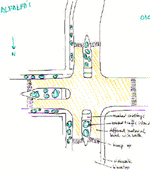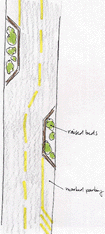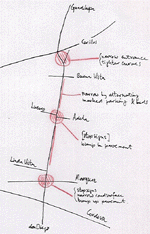click on the pictures to enlarge them

|

|

|

|

|
December 1995
Hubert van Hecke
The traffic situation on Don Diego has emerged as one of the central problems of the Don Diego neighborhood. High speeds, the dangers of crossing on foot, and the sheer volume of the traffic have come up as major concerns at all of the meetings of the recently reconstituted neigborhood organization.
In this note I would like to offer a 'European' perspective on the problem. In Europe, no less than in the US, the car is king. However, when a community decides that enough is enough, and that it is time to take back streets for pedestrians and bicyclists, the measures taken are usually more far-reaching than simply putting up stop signs.
|
The photographs from St. Genis show the approach to what used to be a
difficult intersection (see photos St.Genis 1-2). This used to be where a
sideroad joined the main street. The main street was straight and fast,
making it difficult for the side-road traffic to enter, and dangerous for
pedestrians to cross. Now, on the approach to the intersection, there is a
2-foot section of cobblestones which raises the road level to that of the
sidewalk. There is also a change of color of the asphalt. The cobblestones
form a speedbump, though not a severe one, but the visual effect of the
bump plus the change in pavement catches the attention of drivers and is
very effective in slowing down traffic. In addition, the fact that at the
actual center of the intersection the road surface is level with the
sidewalk makes it an intersection that is friendly to strollers,
wheelchairs and the like.
Another technique which effectively slows down traffic is to make the road
look narrower than it actually is. A two-lane street with raised planters
right at the curbside 'feels' a lot narrower than the same two-lane street
with only flat white lines on it.
click on the pictures to enlarge them
|
|
|
In the accompanying sketches I have applied some of these techniques to
Don Diego. Figure 1 shows the current situation at the intersection with
Camino de los Marquez. Each of the arms of the intersection is about 35'
wide. This is a considerable distance when fast traffic is pitted against
a non-fleetfooted pedestrian. Figure 2 shows a modified situation where
the traffic is encouraged to slow down with a bump, a narrowing of the
pavement and a change of surface. Figure 3 shows a perspective view of
such an approach. The distance that pedestrians have to cross has almost
been cut in half. In this situation, a 4-way stop might not even be
necessary.
Figure 4 shows an alternative arrangement. The pedestrian crossing distances have been cut in half, but I believe this solution does not tend to slow down traffic as much as in fig. 2. At the near-crossing of Lucero/Adela, a bump and pavement change might be sufficient to slow down traffic at the midpoint on Don Diego (see figure 5). Note that putting stop signs there might be problematic, since it is not very clear what the right-of-way rules are at this almost-but-not-quite-straight crossing. To attack the problems at the entry to Don Diego at the Cerillos end, the best solution would be to move the entry to the former location, such that Don Diego does not line up with Guadelupe. This may be unrealistic in the short term. Instead, narrowing the road, and increasing the sharpness of the s-curve would effectively slow down traffic there (see fig. 6). As it is now, there is so much space there that cars can accelerate considerably even before they exit from the s-curve. Along the length of Don Diego, we may employ devices as shown in the photos from Meyrin, to make the strees effectively no longer a straight shot (fig. 7) In addition to improving the traffic situation, these measures also make the street look more attractive. |
|

Fig.4 |

Fig.5 |

Fig.6 |

Fig.7 ??? |

Fig.8 |
|||